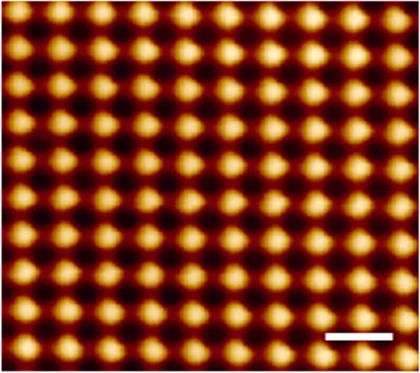March 28, 2016 report
Nanocones may boost solar cell efficiency by 15 percent

(Phys.org)—A team of scientists at Royal Melbourne Institute of Technology in Australia has announced the development of a nanostructure material made of what they are calling nanocones—it is a type of nanomaterial that can be added to boost the efficiency of photovoltaics by increasing their light absorbing abilities. In their paper published in the journal Science Advances, the team describes the new material, how it works, and their hopes for its use in a wide variety of photovoltaic applications.
The new cone structured material's positive attributes come about due to an ultrahigh refractive index—each cone is made of a type of material that acts inside as an insulator and outside as a conductor—under a microscope the material looks like a mass of bullets stood up on end atop a flat base. It, like other topological insulators, exploits oscillations that occur as a result of changes in the concentration of electrons that come about when the material is struck by photons. Each cone has a metal shell coating and a core that is based on a dielectric—a material made with them would be able to provide superior light absorption properties, making it ideal for not just solar cells, but a wide variety of photovoltaic applications ranging from optical fibers to waveguides and even lenses. The researchers suggest that if such a material were to be used as part of a traditional thin-film solar cell, it could increase light absorption by up to 15 percent in both the visible and ultraviolet range.
In interviews with the press, the researchers pointed out that theirs is the first time that such a nanocone structure has been created and perhaps just as importantly, noted that creating them would not require any new fabrication techniques. Also, they suggested that because of the better light absorption properties of the new material, "both the short circuit current and photoelectric conversion efficiency could be enhanced."
The researchers also note that unlike other nanostructures the oscillations generated by the nanocones are polarization insensitive, which means they do not have to be directionally perpendicular to nanoslits making them more useful in a wider array of applications because they can be directly integrated into current hardware. They add that they next plan to shift their efforts towards focusing on plasmonics that occur in other sorts of structures with different types of shapes.
More information: Z. Yue et al. Intrinsically core-shell plasmonic dielectric nanostructures with ultrahigh refractive index, Science Advances (2016). DOI: 10.1126/sciadv.1501536
Abstract
Topological insulators are a new class of quantum materials with metallic (edge) surface states and insulating bulk states. They demonstrate a variety of novel electronic and optical properties, which make them highly promising electronic, spintronic, and optoelectronic materials. We report on a novel conic plasmonic nanostructure that is made of bulk-insulating topological insulators and has an intrinsic core-shell formation. The insulating (dielectric) core of the nanocone displays an ultrahigh refractive index of up to 5.5 in the near-infrared frequency range. On the metallic shell, plasmonic response and strong backward light scattering were observed in the visible frequency range. Through integrating the nanocone arrays into a-Si thin film solar cells, up to 15% enhancement of light absorption was predicted in the ultraviolet and visible ranges. With these unique features, the intrinsically core-shell plasmonic nanostructure paves a new way for designing low-loss and high-performance visible to infrared optical devices.
Journal information: Science Advances
© 2016 Phys.org





















